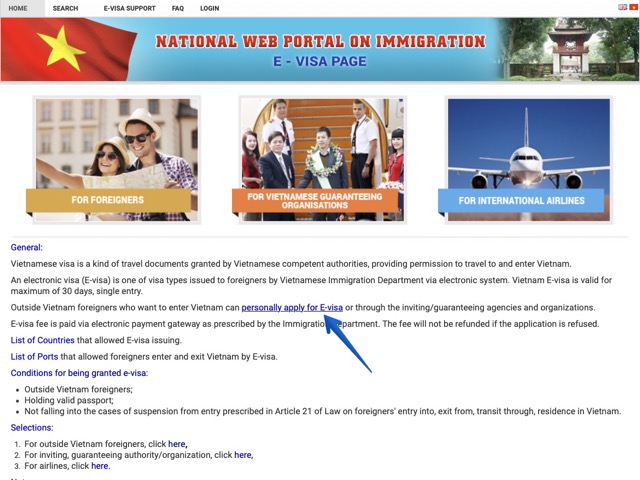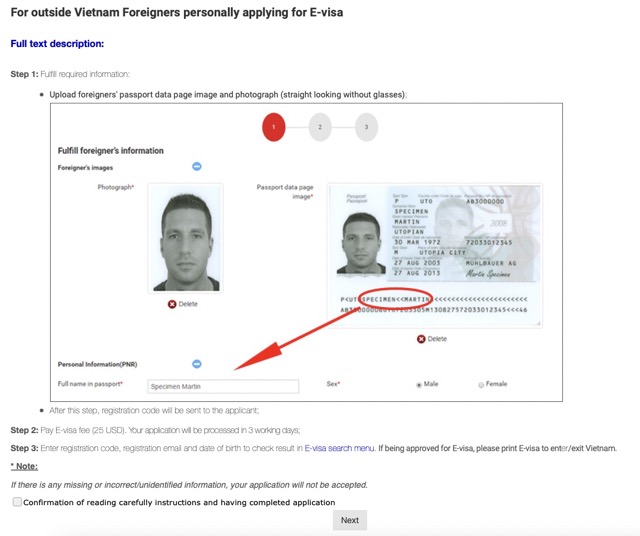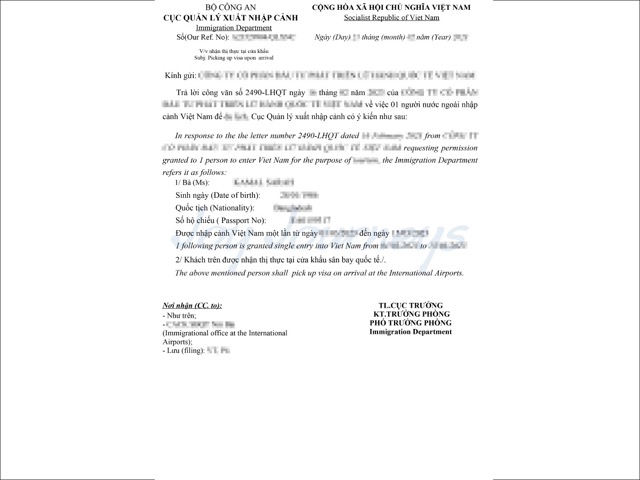Traveling to Vietnam is now much easier with e-visa. Let’s explore the convenience and benefits of Vietnam’s e-Visa for foreign tourists. Discover how this streamlined process can simplify your travel plans, making your journey to Vietnam a hassle-free and enjoyable experience.
See more: Requirements to Travel to Vietnam – Everything You Need to Know Before Your Trip
Contents
- 1 What is a Vietnam e-Visa?
- 2 Vietnam e-visa and Traditional Visa
- 3 E-Visa Vietnam Duration
- 4 A Step-by-Step Guide to Obtaining Your Vietnam e-Visa
- 5 Vietnam E-Visa Fees & Processing Time
- 6 Using Your E-visa: A Hassle-Free Experience
- 7 Useful tips and advice for travelers applying for an E-visa to Vietnam
- 8 Conclusion
What is a Vietnam e-Visa?
Vietnam’s e-Visa is a digital travel document revolutionizing the tourist visa application process. This electronic visa, known as e-Visa, offers a streamlined and efficient way for travelers to obtain permission to enter Vietnam.
The significance of Vietnam’s e-visa lies in its ability to simplify and expedite the traditionally complex visa process. It allows tourists to apply for their visas online, eliminating the need for physical paperwork and long embassy visits.
One of its key advantages is accessibility. Travelers can apply for an e-Visa from anywhere in the world with an internet connection, making it a convenient option for those planning a trip to Vietnam.
Moreover, the e-Visa process is user-friendly, requiring applicants to fill out an online form with personal information and travel details. This straightforward process reduces the likelihood of errors and enhances the efficiency of visa approval.

Vietnam e-visa and Traditional Visa
When planning your visit to Vietnam, one crucial decision is selecting the right visa type. Here, we will compare the benefits and distinctions between the Vietnam e-visa and a traditional visa options to help you make an informed choice.
Vietnam e-visa: Convenience at Your Fingertips
- Ease of Application: The e-visa application process is entirely online, eliminating the need for in-person visits to embassies or consulates.
- Efficiency: With processing times typically around three working days, e-visas offer a quicker turnaround compared to some traditional visa options.
- Cost-Efficiency: The flat fee of 25 USD per person makes e-visas a cost-effective choice for many travelers.
- Accessibility: E-visas can be obtained from anywhere with an internet connection, enhancing accessibility.
Traditional Visa: Tailored for Specific Needs
- Visa Types: Traditional visas offer various types, including tourist, business, and diplomatic visas, catering to different travel purposes.
- Longer Durations: Some traditional visas allow for longer stays, which can be advantageous for extended trips.
- Entry Options: Depending on the visa type, traditional visas may offer multiple entries or flexibility in entry points.
To make an informed decision, assess your travel requirements and preferences. If you seek convenience, cost-efficiency, and a straightforward process, the e-visa is likely your best choice. However, if your trip involves specific purposes or a longer stay, exploring traditional visa options may be beneficial.
Find out the best season to visit Vietnam.
E-Visa Vietnam Duration
Understanding the duration and flexibility of your Vietnam e-Visa is essential for planning your visit. In this section, we’ll delve into the validity period and entry conditions of your e-Visa, ensuring a well-informed travel experience.
The following information is quoted from “Thu vien phap luat”:
According to the new regulations issued on June 24, 2023, Vietnam has officially extended the duration of the electronic visa (E-Visa) from a maximum of 30 days to a maximum of 90 days for foreign nationals.
(based on Article 2, Clause 2 of the 2023 amended Law on Entry, Exit, and Residence)
Starting from August 15, 2023, foreign nationals, regardless of nationality or country of origin, can apply for the Vietnam e-visa through online means.
Previously, Vietnam had implemented the e-visa system for 80 countries, but with this new resolution, the doors to Vietnam have been opened wider than ever before.
Extension of temporary residence duration to 45 days for citizens of 13 visa-exempt countries
Starting from August 15, 2023 (the effective date of Resolution 128/NQ-CP), visa exemption for citizens of the following countries: the Federal Republic of Germany, the French Republic, the Italian Republic, the Kingdom of Spain, the United Kingdom and Northern Ireland, the Russian Federation, Japan, the Republic of Korea, the Kingdom of Denmark, the Kingdom of Sweden, the Kingdom of Norway, the Republic of Finland, and the Republic of Belarus, is extended to 45 days from the date of entry, regardless of passport type or purpose of entry, based on meeting the entry requirements as stipulated by Vietnamese law.
Previously, under Resolution 32/NQ-CP, the temporary residence duration for citizens of these 13 countries was 15 days.
The visa exemption policy for the mentioned countries will be implemented for a period of 3 years, from March 15, 2022, to March 14, 2025, and will be subject to extension according to Vietnamese law.
Changes in the duration of certain visa types for foreign nationals
Starting from August 15, 2023, the visa duration will be changed according to the provisions of the amended 2023 Law on Entry, Exit, and Residence as follows:
- SQ visa: not exceeding 30 days
- HN, DL, EV visas: not exceeding 90 days
- VR visa: not exceeding 180 days
- NG1, NG2, NG3, NG4, LV1, LV2, ĐT4, DN1, DN2, NN1, NN2, NN3, DH, PV1, PV2, TT visas: not exceeding 1 year
- LĐ1, LĐ2 visas: not exceeding 2 years
- ĐT3 visa: not exceeding 3 years
- LS, ĐT1, ĐT2 visas: not exceeding 5 years
- Expired visas will be considered for renewal.
- The visa duration should be shorter than the passport or international travel document validity by at least 30 days.
6 cases of visa exemption
The visa exemption cases are specified in Article 12 of the 2014 Law on Entry, Exit, Transit, and Residence of Foreigners in Vietnam (amended in 2019), including:
- Based on international treaties of which Vietnam is a member.
- Using permanent resident cards or temporary resident cards as stipulated in the 2014 Law on Entry, Exit, Transit, and Residence of Foreigners in Vietnam.
- Entering economic zones, administrative-economic units.
- Entering coastal economic zones as decided by the Government, provided that they meet certain conditions: having international airports; having separate spaces; having defined geographical boundaries, separated from the mainland; being compatible with the socio-economic development policy and not detrimental to Vietnam’s national defense, security, order, and social safety.
- According to the provisions of Article 13 of the 2014 Law on Entry, Exit, Transit, and Residence of Foreigners in Vietnam.
- Vietnamese citizens residing abroad with passports or international travel documents issued by competent foreign authorities and foreigners who are spouses, and children of Vietnamese citizens; foreigners who are spouses, and children of Vietnamese citizens are exempt from visas according to the regulations of the Government.
A Step-by-Step Guide to Obtaining Your Vietnam e-Visa
If you’re planning a trip to the captivating country of Vietnam, securing your e-Visa is an essential part of the process. This electronic visa system has streamlined the entry process for travelers from numerous countries, making exploring Vietnam’s rich culture and picturesque landscapes easier. This informative guide will walk you through the six essential steps to obtain your Vietnam e-Visa, ensuring a seamless journey ahead.
Prepare Your Documents
Before you embark on your e-Visa application journey, gathering the necessary documents is crucial. These include:
- Ensure your passport has a minimum validity of six (6) months.
- Prepare a passport-sized photo in .jpg format (4×6, white background, without glasses).
- Provide a clear .jpg format image of your entire passport data page.
- Have a valid international credit or debit card ready for payment.
- Furnish an active email address for support and communication.
- Provide details of your temporary address within Vietnam.
- Specify your intended entry and exit dates, along with the chosen entry and exit points or airports.
Access the Official Website
To kickstart your e-Visa application, follow these steps:
Visit the Official Website: https://evisa.xuatnhapcanh.gov.vn/

Complete the Online Application
Now, it’s time to fill out the online application form:
Accurate Information: Provide precise personal details, travel information, and passport details. Accuracy is critical, as any errors can lead to delays or even rejections.
Upload Documents
To proceed with your application, you must upload specific documents:
Passport and Photo: Upload a clear digital copy of your passport’s biographical page and the passport-size photo. These documents must adhere to the specified size and format guidelines to avoid complications.

Pay the Application Fee
The e-visa application process involves a processing fee, which varies depending on your nationality and the type of e-visa you’re applying for:
Payment Methods: Pay the processing fee using the available online payment methods. Ensure you retain the payment confirmation for your records. The cost varies based on your nationality and visa type, so be prepared accordingly.
Receive and Download Your e-Visa
Once you’ve completed the previous steps, you’re on the path to obtaining your Vietnam e-Visa:
Application ID: After submitting your application and payment, you will receive an application ID or reference number. Keep this number safe, as you’ll need it for tracking your application.
Check Your Email: Regularly check your email for updates on your e-Visa status. This is where you’ll receive notifications regarding your application’s progress.
Download Your e-Visa: Upon approval, you will receive an email with a link to download and print your e-Visa. It is recommended to have both digital and physical copies of your e-Visa with you when traveling to Vietnam.
Vietnam E-Visa Fees & Processing Time
As you plan your visit, it’s important to understand the costs and processing time of your Vietnam e-visa. Now, let’s explore the application process and required documents for a successful visa application.”
Vietnam E-Visa Cost
When planning your trip to Vietnam, it’s crucial to understand the fees associated with obtaining an e-visa. The cost for a Vietnam e-visa is a flat fee of 25 USD per person. It’s important to note that this fee is non-refundable, regardless of whether your visa application is approved or not. Therefore, it’s advisable to double-check your eligibility and application details to ensure a smooth process.
Processing Time
The processing time for a Vietnam e-visa is typically three working days. However, it’s essential to consider potential delays due to a high volume of applicants or public holidays. It’s recommended to apply for your e-visa at least 1-2 weeks before your planned departure date to avoid last-minute complications. This buffer allows for any unforeseen delays and ensures you have your e-visa ready in time for your trip.
By being aware of the cost and processing time associated with a Vietnam e-visa, you can plan your travel arrangements more effectively. Remember that thorough preparation and early application are key to a hassle-free journey to this beautiful Southeast Asian destination.
The approved letter can be received through a travel agency or sponsor based in Vietnam.
The traveler’s visa will then be stamped onto their passport by the immigration official, enabling them to enter Vietnam. (Source for visa application fees can be found here and here).

Using Your E-visa: A Hassle-Free Experience
One of the standout advantages of the Vietnam e-visa is its ease of use upon arrival in the country. Here’s how to make the most of your e-visa:
- Present Your E-Visa: Upon arrival at a designated entry point, present your e-Visa along with your passport to the immigration authorities. They will verify your documents, stamp your passport, and grant you entry into Vietnam.
- Entry Gates and Points: The convenience of the e-visa extends to various entry gates and points in Vietnam. You can use your e-Visa at the following locations:
- International airports, including: Cat Bi Int Airport (Hai Phong), Cam Ranh Int Airport (Khanh Hoa), Can Tho International Airport, Da Nang International Airport, Noi Bai Int Airport (Ha Noi), Phu Bai Int Airport, Phu Quoc International Airport, Tan Son Nhat Int Airport (Ho Chi Minh City)
- Seaports, including Chan May Seaport, Da Nang Seaport, Duong Dong Seaport, Hon Gai Seaport, Hai Phong Seaport, Nha Trang Seaport, Nhơn Quy Nhon Seaport, Ho Chi Minh City Seaport, Vung Tau Seaport.
- Landports, including: Bo Y Landport, Cha Lo Landport, Cau Treo Landport, Huu Nghi Landport, Ha Tien Landport, Lao Bao Landport, Lao Cai Landport, La Lay Landport, Moc Bai Landport, Mong Cai Landport, Nam Can Landport, Na Meo Landport, Song Tien Landport, Tinh Bien Landport, Tay Trang Landport, Xa Mat Landport
- Enjoy the Convenience: With your e-visa, you can enjoy a smooth and hassle-free entry process. The e-visa streamlines your arrival, reducing wait times and paperwork. It’s a testament to Vietnam’s commitment to welcoming travelers with open arms.
Understanding Vietnam currency for a smooth journey.
Useful tips and advice for travelers applying for an E-visa to Vietnam
Travelers can look up the most recent details on the Vietnam e-visa application process on the following official Vietnamese government websites: The most updated and trustful information regarding the e-visa application procedure, visa requirements, and any modifications or updates to the visa policy can be found on the websites of the Vietnamese Immigration Department and the Embassy of Vietnam. (Source can be found here)
Travelers can also contact their travel agency if they use one to arrange their journey to Vietnam. They may have the most recent instructions on the e-visa application procedure and any adjustments to the visa requirements.
To account for processing and potential delays, apply for the e-visa as early as possible. Applying far ahead of your anticipated travel dates is advised because the e-visa application procedure can take up to three to five working days.
With your e-visa application, always include correct and comprehensive information about yourself, your travel plans, and the reason for your visit.
Any mistakes or inconsistencies in the application could cause delays or cause the e-visa to be rejected. After the application, you should check the status of your e-visa process by visiting the Vietnam e-visa website’s official page. (Source can be found here, clauses 7, 8, 9, and 10)
Follow up with the Vietnamese Immigration Department or the e-visa system help desk for assistance if your application has any problems or delays.
Conclusion
Above all, here are some takeaways that we hope you can get through this article. Travelers should ensure their eligibility, gather the necessary documentation, apply online, pay the application cost, and print their approved e-visa before leaving for Vietnam.
Travelers can check official Vietnamese government websites, the Vietnam e-visa website, travel companies, embassies or consulates, and online forums or communities to find the most accurate details about the e-visa application procedure and visa conditions.
Travelers should apply early, give accurate and complete information, double-check documents, pay the correct amount, and check on the application status to guarantee a fast and effective approval procedure for an e-visa application to Vietnam.
We hope this article has provided sufficient information to help you plan your vacation to Vietnam in obtaining the E-Visa. If you have any additional questions about the E-Visa process for Vietnam, we would be more than willing to assist you.


Related Posts
Vietnam Motorbike Adventures: The Ultimate Guide
With its breathtaking landscapes, rich cultural heritage, and vibrant local experiences, Vietnam offers an unforgettable adventure for motorbike enthusiasts. Discover hidden gems, meet friendly locals, and create lasting memories as you explore diverse terrains and immerse yourself in the heart of Vietnam. Contents1 Why Choose a Motorbike Adventure in Vietnam?1.1 Freedom and Flexibility1.2 Scenic Routes1.3 […]
Experience the Living Conditions in Cu Chi Tunnels: Unbelievable!
Cu Chi Tunnels served as the living quarters for soldiers and civilians during Vietnam’s resistance against France and America. Today, this remarkable site stands as a symbol of perseverance, determination, and resilience during one of the most challenging periods in Vietnamese history. Discover the living conditions in Cu Chi Tunnels with Joy Journeys in the […]
Vietnam Fish Cake: A Culinary Delight
Vietnam fish cake, known for its delicious and diverse flavors, is a favorite among tourists looking to explore authentic Vietnamese cuisine. From the crispy, golden-brown texture of fried fish cakes to the fragrant, herb-infused variations found in regional specialties, these savory delights offer a true taste of Vietnam. In this article, we will take you […]